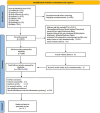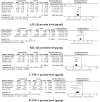Plant-derived extracts or compounds for Helicobacter-associated gastritis: a systematic review of their anti-Helicobacter activity and anti-inflammatory effect in animal experiments
- PMID: 40264171
- PMCID: PMC12013188
- DOI: 10.1186/s13020-025-01093-2
Plant-derived extracts or compounds for Helicobacter-associated gastritis: a systematic review of their anti-Helicobacter activity and anti-inflammatory effect in animal experiments
Erratum in
-
Correction: Plant-derived extracts or compounds for Helicobacter-associated gastritis: a systematic review of their anti-Helicobacter activity and anti-inflammatory effect in animal experiments.Chin Med. 2025 Aug 8;20(1):124. doi: 10.1186/s13020-025-01139-5. Chin Med. 2025. PMID: 40781328 Free PMC article. No abstract available.
Abstract
Background: Helicobacter infection, which is the leading cause of gastritis and stomach cancer, has become common worldwide. Almost all Helicobacter-infected patients have chronic active gastritis, also known as Helicobacter-associated gastritis (HAG). However, the eradication rate of Helicobacter is decreasing due to the poor efficacy of current medications, which causes infection to recur, inflammation to persist, and stomach cancer to develop. Natural components have robust antibacterial activity and anti-inflammatory capacity, as confirmed by many studies of alternative natural medicines.
Purpose: This article aimed to conduct a comprehensive search and meta-analysis to evaluate the efficacy of anti-Helicobacter and anti-inflammatory activities of plant-derived extracts or compounds that can treat HAG in animal experiments. We intended to provide detailed preclinical-research foundation including plant and compound information, as well as the mechanisms by which these plant-derived substances inhibit the progression of Helicobacter infection, gastritis and neoplasms for future study.
Methods: The systematic review is aligned with the guidelines outlined in the Preferred Reporting Items for Systematic Reviews and Meta-Analyses (PRISMA) statement, and the protocol was registered in PROSPERO (CRD42024527889). An extensive search was performed across multiple databases, including PubMed, Scopus, Web of Science, Embase, China National Knowledge Infrastructure (CNKI), the Chinese Scientific Journal database (VIP), the Wanfang database, and the China biomedical literature service system (SinoMed), up until November 2023. Meta-analysis on Review Manager software (RevMan 5.4) estimating anti-Helicobacter and anti-inflammatory activity was performed. We used the Systematic Review Center for Laboratory Animal Experimentation (SYRCLE) risk of bias tool to evaluate the risk of bias of each study included.
Results: Our study encompassed 61 researches, comprised 36 extracts and 37 compounds improving HAG by inhibiting Helicobacter infection, the inflammatory response, oxidative stress, and regulating apoptosis and proliferation. Sixteen families especially Asteraceae, Fabaceae and Rosaceae and nine classes including Terpenoids, Alkaloids, Phenols, and Flavonoids may be promising directions for valuable new drugs. The Meta-analyse demonstrated the plant-base substance treatments possess significant anti-Helicobacter and anti-inflammation activity comparing to control groups. The included plants and compounds confirmed that signaling pathways NF-κB, JAK2/STAT3, MAPK, TLR4/MyD88, PI3K/AKT, NLRP3/Caspase-1 and NRF2/HO-1 play a key role in the progression of HAG.
Conclusion: Plant-derived extracts or compounds actively improve HAG by modulating relevant mechanisms and signaling pathways, particularly through the anti-Helicobacter and inflammatory regulation ways. Further researches to apply these treatments in humans are needed, which will provide direction for the future development of therapeutic drugs to increase eradication rate and alleviate gastritis.
Keywords: Compound; Helicobacter; Helicobacter-associated gastritis; Inflammation; Phytotherapy; Plant extract.
© 2025. The Author(s).
Conflict of interest statement
Declarations. Ethics approval and consent to participate: Not applicable. Consent for publication: Not applicable. Competing interests: The authors declare that they have no competing interests.
Figures














References
-
- Correa P, Haenszel W, Cuello C, Tannenbaum S, Archer M. A model for gastric cancer epidemiology. Lancet. 1975;2(7924):58–60. - PubMed
-
- Correa P. Human gastric carcinogenesis: a multistep and multifactorial process–First American Cancer Society Award Lecture on Cancer Epidemiology and Prevention. Cancer Res. 1992;52(24):6735–40. - PubMed
Publication types
Grants and funding
- CI2021A00606/Scientific and Technological Innovation Project, China Academy of Chinese Medical Sciences
- CACM-(2022-QNRC2-B06)/Young Elite Scientists Sponsorship Program by China Association of Chinese Medicine
- DZMG-QNGG0005/Funding for Clinical Research at High-Level Traditional Chinese Medicine Hospitals in China Central
- YZX-202237/Fundamental Research Funds for the Central Public Welfare Research Institutes
- YZX-202241/Fundamental Research Funds for the Central Public Welfare Research Institutes
LinkOut - more resources
Full Text Sources
Miscellaneous

